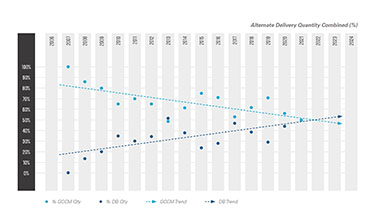|
Subscribe / Renew |
|
|
Contact Us |
|
| ► Subscribe to our Free Weekly Newsletter | |
| home | Welcome, sign in or click here to subscribe. | login |
Construction
| |
 |
September 30, 2021
Progressive design-build is changing the future of K-12 construction
Lease Crutcher Lewis

Moore
|
Construction of K-12 schools is no small feat — from meeting a tight schedule, to strategically investing funds, to delivering a high-quality facility that will serve students and faculty for years to come. K-12 project teams are tasked with building impactful, long-lasting buildings with a set budget and a tight timeline.
But the landscape of K-12 construction is changing. There has been a clear trend of increased utilization of progressive design-build (PDB) for education projects since 2013 when the Washington state Legislature first allowed the delivery method for public agencies.
We are seeing more and more public school districts adopt PDB in Washington state, according to data from the state Alternative Works Project Review Committee. Earlier this year, Tacoma Public Schools was the first school district in the state to receive blanket approval to utilize design-build for all its capital projects. Other school districts currently utilizing design-build include Issaquah, Central Kitsap Schools, Bremerton and Mount Vernon.
I have devoted a significant portion of my career to serving the needs of K-12 capital projects, acting as architect, owner and builder. The integration of design and construction services is a natural progression of the industry’s desire to capitalize on collaboration, reduce waste in the process, and integrate design and construction services.
The PDB approach balances the needs of the owner, designer and builder team — commonly referred to as a “three-legged stool” — so design and construction can be fully integrated from the start. This aligns the team around a single set of goals and eliminates rework and handoffs.
“The PDB approach creates a shared team vision and avoids siloed thinking, which drives success on the district’s terms,” said Heather Hocklander, principal with BCRA.
DELIVERING A COMPLEX BUILDING
Public K-12 schools are complex by nature. Having to provide for numerous and sometimes opposing operational programs, complex multi-use spaces like gymnasiums, cafeterias and auditoriums, advanced safety and security requirements to protect students and staff, intensive IT infrastructure that will adapt throughout the life of the building, complex mechanical systems, and long-term operational efficiency and maintainability considerations.
Schools also involve a large array of stakeholders with diverse and sometimes competing interests, limited funding, and schedule constraints commonly involving phased construction on occupied campuses. A successful project will reflect the needs of the district, which will fundamentally be determined by the students, parents, staff and general public’s perception of the process and the completed project. These stakeholders expect close collaboration of the owner and design-build team and confidence that they are receiving the best value for their funds and that their voices are heard.
“To be successful, appropriate planning, scoping and budgeting needs to be done in advance with key project team members; designers, builders and select specialty trade partners, before starting design,” said Morris Aldridge, executive director of planning and construction for Tacoma Public Schools.
THE SYNERGY OF COLLABORATION
Progressive design-build puts owners in the driver’s seat and allows them to identify what “best value” means to their stakeholders — rather than awarding projects purely on the lowest bid. In my experience, best value can include getting the most building area, performance and quality for their dollar, delivering the building under a shortened schedule, and meeting DEI goals. The design-build team can align around the district’s definition of success — working to enhance the scope, maximize the budget and optimize the schedule.
Designers have also achieved a higher level of design excellence by having direct access and commitment from the expertise that will fabricate and install their visions.
“Working collaboratively the owner, builder and design team identify risks and ranked priorities before design begins. As design and construction progress — and more is known — the PDB team can convert risks to rewards, oriented toward delivering more of the owner’s priorities in the final project,” said Michael McGavock, principal at McGranahan Architects.
Students, teachers and faculty must have access to a complete and functional facility on a predictable schedule that coincides with district and school year milestones, so there is no room for schedule creep or unforeseen delays. The PDB process significantly reduces schedule risks by engaging the right project partners from the start, shortening construction time and providing project schedule predictability.
Inclusivity of diverse businesses and workforce individuals is also a clear expectation of many of our communities, and progressive design-build empowers districts to incorporate DEI goals into their overall project goals. The proof is in the results at Tacoma Public Schools.
“We have well exceeded the stipulated participation goals on all projects, and the cost per square foot of the projects has been less than other delivery methods,” said Aldridge.
The alternative delivery method sets the team up for success by harnessing each team’s collective expertise to accomplish a district’s distinctive project goals.
“The PDB process provides the greatest opportunity to achieve true design excellence,” said Kris Stamon, architect and project manager at McGranahan Architects.
The process focuses on solutions that provide the overall best value defined by the district and its stakeholders. The entire team can focus on meeting community and stakeholder goals, not leaving this as just the burden of the district.
Progressive design-build continues to enable architects, contractors and school districts to provide high-quality learning spaces for students, faculty and the communities they serve. While Tacoma Public Schools was the first to receive universal approval for design-build use, many more districts are discovering the tangible value that the PDB method brings to their stakeholders. I anticipate that many more students across the state will be learning in spaces specifically designed and built to serve their unique needs delivered by this method.
Casey Moore is a project executive at Lease Crutcher Lewis and is also versed in the owner’s role, recently serving as the director of capital programs for Federal Way Public Schools and as director of school facilities organization for the Office of the Superintendent of Public Instruction.
Other Stories:
- Nature and nurture in Renton's Cascade/Benson Hill neighborhood
- Exploring the benefits of mass timber
- School ventilation strategies for a pandemic
- How schools and designers can manage crises
- Effective learning design in the state-of-the-art Honouliuli Middle School
- Strategic energy planning for equity and resilience
- Providing for diversity in K-12 schools
- Trauma-informed design in schools



